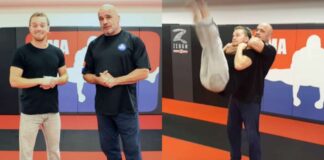
Introduction
It is tied so tightly in most people’s heads that when the word “nunchaku” is mentioned, Bruce Lee, his speed of movement, and the metallic “whoosh” sound are immediately conjured up.
This staple weapon in the martial arts, often referred to as “nunchucks,” became the “in” thing around the world in the seventies, largely due to the kung fu films’ mesmerizing use of it. Practically, it was depicted as the lethal, invincible weapon of the martial arts mastermind. However, the story of the nunchaku, behind that martial arts legend, is complicated for a start and also widely disputed.
To begin with, the history of nunchaku is far from straightforward. It is a fascinating story that, for the most part, is quite dark, taking the way from the tool of the farm to the symbol of the rebellion and finally to a cultural icon of the entire world. Knowing the true nunchuck history demands one to distinguish the real facts from the lies of Hollywood.
The Great Debate: Weapon or Farm Tool?
One of the most talked-about and highly romanticized of the nunchaku historical tales is that it originated as the weapon with which the Okinawan peasants fought their oppressors. According to the legend, the story of nunchaku starts with the arrival of a Japanese Satsuma Samurai clan at Okinawa in the 17th century and their subsequent banning of all kinds of weapons.
With the peasants turning from the victims to the masterminds, they are said to have taken their tools from the farm and reworked them into weaponry and a fighting system (later known as Kobudo) to defend themselves. The narrative of the nunchucks as originating from a rice flail (a tool used for threshing grain by beating it) is central to the story that goes with it.
The argument is that two wooden sticks joined with a cord or chain could easily pass off as an ordinary tool if a samurai happened to be around, but could also be used as a weapon during a revolt. This “peasant weapon” theory is a very compelling one, yet a lot of present-day martial arts historians have refuted it and now propose the history of nunchaku to be something else.
Alternative Theories on the Nunchaku’s Origin
Though the “rice flail” account is well-accepted, its backup evidence is quite lacking. Many historical researchers maintain that there is almost no evidence that peasants in Okinawa used flails as a weapon and actually trained with them.
One of the alternatives to this theory is a suggestion that the nunchaku was not derived from a flail but from the horse’s bit (a muge in Japanese), the piece of the animal’s gear that goes into the mouth. The more convincing theory amongst the two says that the nunchaku was not the device for the peasants, but rather the invention of the Okinawan aristocracy or shizoku (the class of scholar-officials), who were trained in the martial arts. They might have obtained it from Chinese arms or the development of other jointed staffs.
Some even believe the nunchuck history to be originated from China or Southeast Asia and later brought to Okinawa through the means of trade. The fact is that the exact, recorded source is gone with the times, thereby making the history of nunchaku a curious case of the past. What is definite, however, is that it was the place in Okinawa where the weapon was systematized into a true martial art.
The Man Who Made the Nunchaku Famous
For a long time, nunchaku was a relatively quiet and not widely known weapon of the Okinawan martial arts that were kept secret primarily among Kobudo practitioners. So how did it manage to become one of the most widely known weapons of the world? Well, the answer is one single guy: Bruce Lee. Bruce Lee, in the 1970s, was in search of a weapon that would not only be visually impressive but also ‘cinematic’ for his movies. The nunchaku was the one. In a flash, he made the nunchaku the new sensation by his incomparable speed, accuracy, and unrefined charm in the movies Fist of Fury and Way of the Dragon. He was not simply wielded it; rather, he turned it into a part of his body. So suddenly, millions of people wanted to be Bruce Lee, and the nunchaku sales went up like a rocket. This was really the point in the nunchaku’s past when it went from being pretty much unknown to becoming a worldwide symbol.
The Inevitable Backlash: Legality and Misunderstanding
However, the rise to stardom was not without its limitations. As films and television shows (like Teenage Mutant Ninja Turtles) kept on portraying the nunchaku, it was also getting a reputation of the most dangerous “thug” or “gang” weapon that attracted the oriented at the public and lawmakers, respectively. During the 70s and 80s, a moral panic of large proportion was experienced in various nations and U.S. states which resulted in nunchaku being banned. It was considered an illegal weapon along the likes of switchblades and brass knuckles. The legal backlash which followed marked a major, though very unfortunate, episode in the modern history of nunchucks. The laws acted as a big slap in the face for martial artists who used the nunchaku as a tool for self-discipline, self-defense, and improving body coordination. Right now, the legality of nunchaku ownership, carrying, and performing still wildly differs from place to place, and a handful of locations continue to have very rigid bans in force.
The Nunchaku Today: From Weapon to Art Form
Right now, the nunchaku history has gone beyond the stage it once was. Even though the nunchaku is still considered a weapon in martial arts such as Okinawan Kobudo and certain Karate styles, its main identity has changed. It has become a very popular “flow art” that is similar to staff spinning or poi. Today’s nunchaku practitioners, or “freestyle” nunchaku artists, as they are sometimes termed, are mainly concentrated on the difficult, brilliant, and dance-like aspects of their tool manipulations. They play with various grips, elaborate aerials, and multi-chaku (using two or more nunchaku at once) to reach higher levels of their art. The result of this has been a lively community that is characterized by the pursuit of skillfulness, originality, and flow rather than the usage of the weapon for fighting. At the same time, however, practitioners of the martial arts continue to perform drills with the weapon, emphasizing the discipline of its traditional kata (forms) and the practical aspects of its strikes, blocks, and joint-locks. The whole thing is pretty deep, and the history of nunchaku, if gone into in detail, shows far beyond what we see on the screen.
Conclusion
The nunchaku is an intriguing item, a minimal instrument made of two sticks and a cord, but which carries a very complicated, heavy, and quite often also a misunderstood legacy. Its real beginnings might be untraceable now, but its voyage is still visible. Through the influence of the cinema, it has metamorphosed from a mysterious Okinawan instrument into an universal symbol of the martial arts. It has gone through the time of legal panic and misconception, and now it has come back both as a disciplined martial art and as a creative flow art. Real nunchuck history serves as a strong reminder that the story of an object is not only about where it came from but also about the culture, art, and people that picked it up and thereby gave it new meaning.







